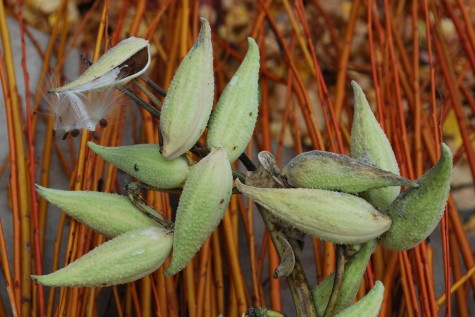
No gardener’s November need be drab. Though the time for planting in ground is drawing to a close, we are just warming up for the late fall, winter, and holiday seasons. Since the winter season in Michigan is every bit as long as the summer, why not celebrate it? We have made a specialty of making all manner of natural materials available to anyone for whom a pot sitting empty and forlorn all winter is not an option. The fantail willow I discussed last week has other equally beautiful relatives. Shrub form dogwood branches are available in a wide range of colors-and I do mean color. Should I ever decide to take up farming, I think I would grow shrubs for their twigs, and milkweeds. The above picture of flame willow and milkweeds is just one idea aimed at decorating November.
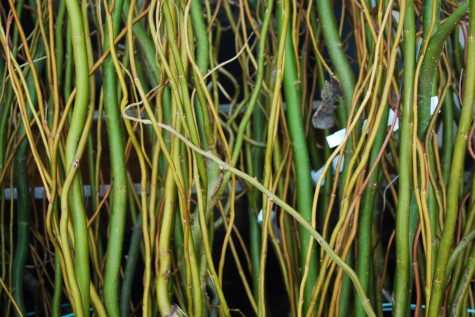
I do have curly willow trees on my shop property. They can be a headache, dropping twigs constantly; one 30 foot tree fell flat to the ground on a very windy day. But what makes them bad also makes them good. We topped that tree at six feet, dragged it upright with a truck and chain, and replanted the exposed portion of its rootball; it is back to growing just fine now. The willows take very well to hard pruning, and provides us with a source of brilliantly colored branches. Barely worth a glance in leaf, the bare branches are luscious in color, form and texture.
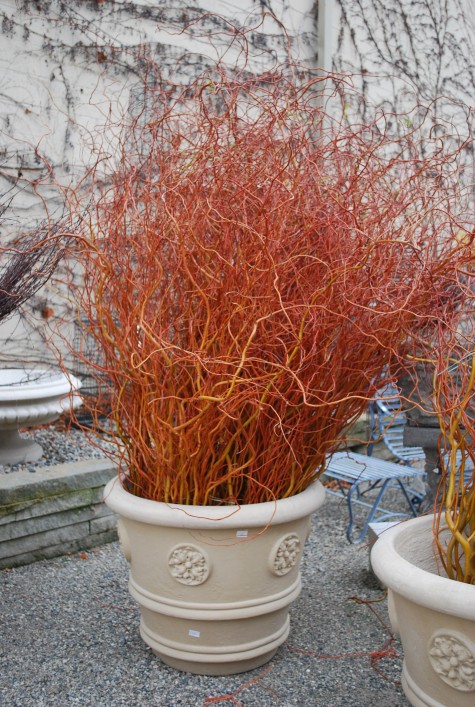
Copper red curly willow-the name says it all. As the new growth has the best color, regular pruning is key. This fresh growth is known as the coppice wood. The stout branches that make up our hazelwood fence panels are harvested in the same way.
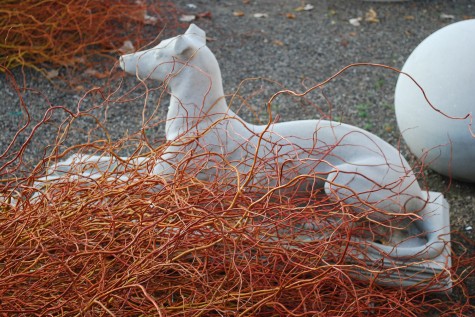 The golden coppery orange is a great foil for the landscape gone to black and white. The fresh branches are limber and pliable. The curly tops can be tied up in a good approximation of a pony tail, or twisted and tied into new shapes not necessarily natural, and perhaps more contemporary.
The golden coppery orange is a great foil for the landscape gone to black and white. The fresh branches are limber and pliable. The curly tops can be tied up in a good approximation of a pony tail, or twisted and tied into new shapes not necessarily natural, and perhaps more contemporary.

Red bud willow comes bundled ten stems to a bunch, and ten bunches to a bale. The stems are straight; the color is good top to bottom. It’s clear these plants are being grown specifically for harvest. Left outside in a pot all winter, the buds will break in the spring. This pussy willow will look great from November on into the following May. Many of the willow stems will root, if they are stuck in soil in a pot. If you arrange all of your materials in dry floral foam as I do, sometimes a fresh cut and a well watered spot in the garden will produce rooting.
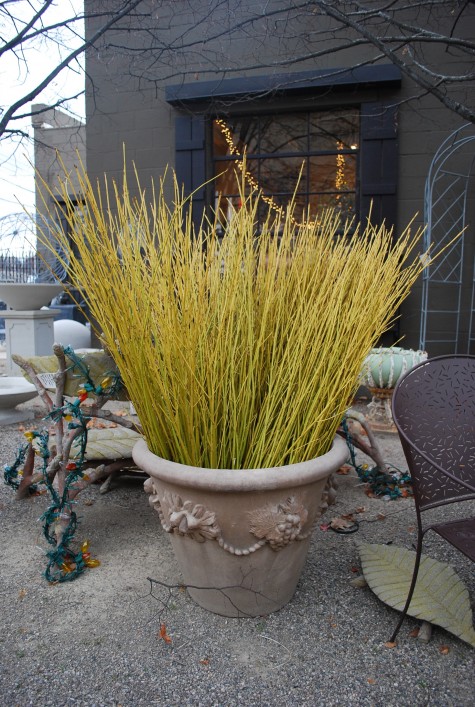 The shrubby dogwoods are every bit as useful as the willows. They also produce the best color on new wood. If you grow these dogwoods in your garden, be sure to prune them down regularly and hard. The old bark of shrubby dogwoods is dull, and invariably scarred by exposure to weather. I rarely see yellow twig dogwood planted any more-plants do go in and out of fashion. This cultivar was specifically bred for color superior to the species- and it delivers.
The shrubby dogwoods are every bit as useful as the willows. They also produce the best color on new wood. If you grow these dogwoods in your garden, be sure to prune them down regularly and hard. The old bark of shrubby dogwoods is dull, and invariably scarred by exposure to weather. I rarely see yellow twig dogwood planted any more-plants do go in and out of fashion. This cultivar was specifically bred for color superior to the species- and it delivers.
 Many cultivars of red twig dogwood are available now. With bark ranging in color from pink-coral to coral, orange red, fire engine scarlet red, and maroon, these twigs make quick work of banishing the winter gardening blues. This cultivar, aptly named “Cardinal” is the brightest red bark I have ever seen. The 1500 stems in this crate makes me wish I could see the entire field from which they were cut-the day the leaves drop. I would bet that view is a perfect gardening moment.
Many cultivars of red twig dogwood are available now. With bark ranging in color from pink-coral to coral, orange red, fire engine scarlet red, and maroon, these twigs make quick work of banishing the winter gardening blues. This cultivar, aptly named “Cardinal” is the brightest red bark I have ever seen. The 1500 stems in this crate makes me wish I could see the entire field from which they were cut-the day the leaves drop. I would bet that view is a perfect gardening moment.
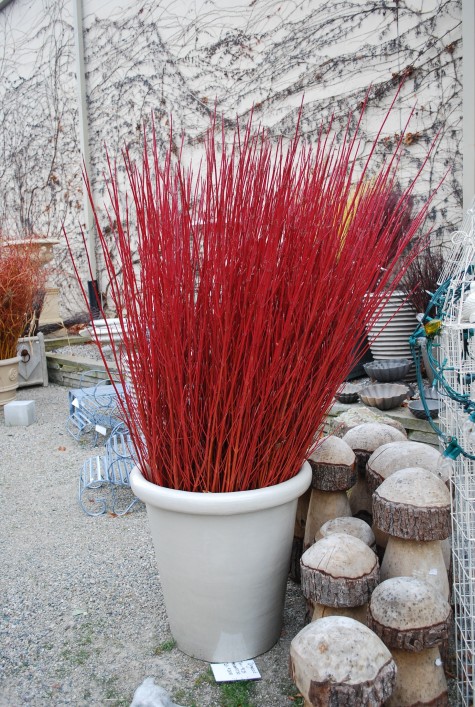 Whatever you might fancy, the dormant garden has plenty to recommend it. The gathering of materials, and the act of decorating for the cold season is an act of Mitchell-esque defiance I can get right behind.
Whatever you might fancy, the dormant garden has plenty to recommend it. The gathering of materials, and the act of decorating for the cold season is an act of Mitchell-esque defiance I can get right behind.
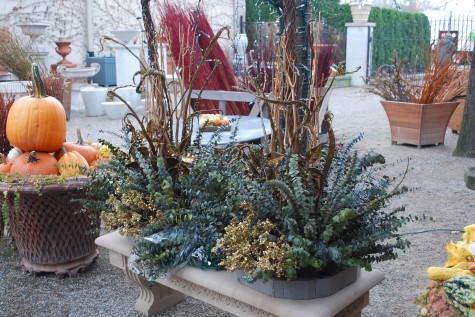
These arrangements are the first of the season out the door. The color is subtle, and most of ther materials natural. The preserved eucalyptus will perform just fine outdoors. The forms are constructed such that my client has only to drop them in her pots, and level them. She is ready and looking forward to the new season.
 My November garden is radically different and edited in character from what I see in the summer-but characters there are. The willows are coming into their own. I wouldn’t give a nickel for a willow in the summer-save the dwarf blue artic willow. Its graceful branches almost always in motion can recreate the feeling of a meadow in a small space. Other willows are coarse in leaf and ungainly in habit-in a word, park-grade. Should you have acres such that the willows can be planted comfortably far away in your park, fine. There are too many other more civilized choices for my small garden to give over space to this group. In November, I rue my rule. The cut branches of salix sachaliensis “sekka” pictured above would not make you rush to your local nursery to buy one, but as with most willows, their bold branches shine now. When the willow leaves finally drop, I kick myself for not having an entire hedge of it in the ground.
My November garden is radically different and edited in character from what I see in the summer-but characters there are. The willows are coming into their own. I wouldn’t give a nickel for a willow in the summer-save the dwarf blue artic willow. Its graceful branches almost always in motion can recreate the feeling of a meadow in a small space. Other willows are coarse in leaf and ungainly in habit-in a word, park-grade. Should you have acres such that the willows can be planted comfortably far away in your park, fine. There are too many other more civilized choices for my small garden to give over space to this group. In November, I rue my rule. The cut branches of salix sachaliensis “sekka” pictured above would not make you rush to your local nursery to buy one, but as with most willows, their bold branches shine now. When the willow leaves finally drop, I kick myself for not having an entire hedge of it in the ground. 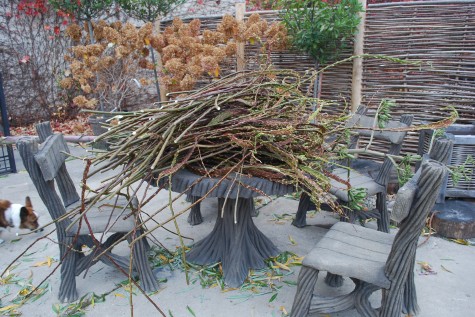 Commonly known as fantail willow, this shrubby plant is known for its fasciated stems. OK-I will cover the science as fast as I can. Meristem cells, from whence all parts of the plant grow, are dome shaped; they produce the cylindrical shapes we know as branches. Either from mutation, or some other force not clearly understood, some meristem cells flatten out, and elongate, producing wide flat stems that may curl in a most unusual way. These bold branches are gorgeous in the garden, and in fall and winter arrangements.
Commonly known as fantail willow, this shrubby plant is known for its fasciated stems. OK-I will cover the science as fast as I can. Meristem cells, from whence all parts of the plant grow, are dome shaped; they produce the cylindrical shapes we know as branches. Either from mutation, or some other force not clearly understood, some meristem cells flatten out, and elongate, producing wide flat stems that may curl in a most unusual way. These bold branches are gorgeous in the garden, and in fall and winter arrangements.  Some floral supply places carry dried fantail willow, but I prize the the fresh cut stems. Each branch colors up individually in the fall in shades of red, green and brown. The cut branches retain their color outdoors in cold weather a very long time; they make a striking centerpiece in holiday and winter pots, in wreaths and door swags.
Some floral supply places carry dried fantail willow, but I prize the the fresh cut stems. Each branch colors up individually in the fall in shades of red, green and brown. The cut branches retain their color outdoors in cold weather a very long time; they make a striking centerpiece in holiday and winter pots, in wreaths and door swags. 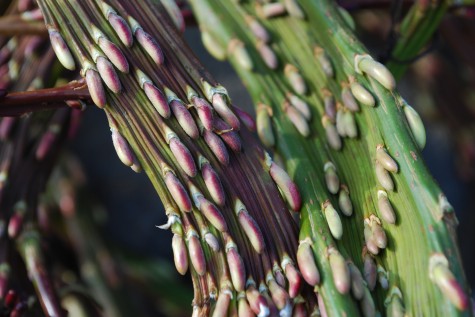 The grooves and furrows, a direct result of the process of fasciation, make for a very bold texture. Note the elongated the leaf buds set for spring. Fasciation can occur in many plants-I have seen two-headed dandelions, and thick flat stems of bulb lilies with their bouffant hairdo of flowers clustered at the top. Some plants may produce stems like this intermittently-these are called witches brooms, after the look of that proliferation of branches. Some witches brooms are cut, and propagated from cuttings. Certain dwarf conifers with very congested and odd branching patterns of questionable appeal come to market via a chance fasciation.
The grooves and furrows, a direct result of the process of fasciation, make for a very bold texture. Note the elongated the leaf buds set for spring. Fasciation can occur in many plants-I have seen two-headed dandelions, and thick flat stems of bulb lilies with their bouffant hairdo of flowers clustered at the top. Some plants may produce stems like this intermittently-these are called witches brooms, after the look of that proliferation of branches. Some witches brooms are cut, and propagated from cuttings. Certain dwarf conifers with very congested and odd branching patterns of questionable appeal come to market via a chance fasciation. 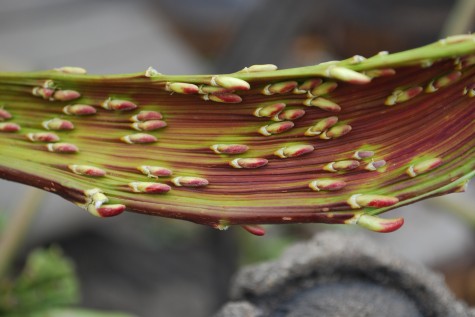 Color can be tough to come by this time of year where I live. I love the natural greys, browns and blacks common to the season, but I so appreciate robust color in a landscape that has by and large gone dormant.
Color can be tough to come by this time of year where I live. I love the natural greys, browns and blacks common to the season, but I so appreciate robust color in a landscape that has by and large gone dormant.
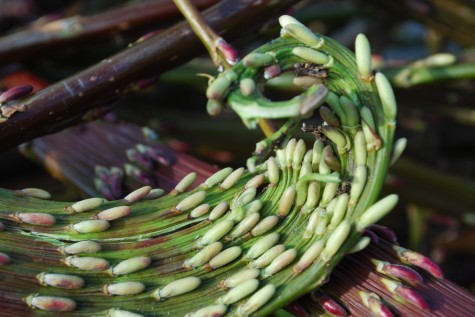
 Fierce winds that went on for several days blew most of all the leaves on the trees to the ground. Yesterday what few leaves on my big maple that survived the initial blow, gave up, floated down, and landed on my drive with an audible sigh. I sighed too; November in Michigan is cold, blustery and unfriendly. My leaves usually fall over a period of weeks; this helps to get used to the idea that winter is not far off. But that all at once drop got me to looking at what is left behind. Tree bark-such beautiful skin.
Fierce winds that went on for several days blew most of all the leaves on the trees to the ground. Yesterday what few leaves on my big maple that survived the initial blow, gave up, floated down, and landed on my drive with an audible sigh. I sighed too; November in Michigan is cold, blustery and unfriendly. My leaves usually fall over a period of weeks; this helps to get used to the idea that winter is not far off. But that all at once drop got me to looking at what is left behind. Tree bark-such beautiful skin. 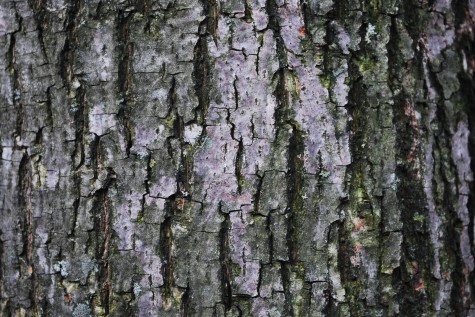 The bark of this linden is comprised of a number of layers-the outermost layer, or cork, is comprised of cells that are no longer living. This cork protects a tree in much the same way that skin protects people. The bark slows the loss of water from the interior living layers of bark. It is a deterrent to insect invasions, fungal and bacterial infection, and damage from animals.
The bark of this linden is comprised of a number of layers-the outermost layer, or cork, is comprised of cells that are no longer living. This cork protects a tree in much the same way that skin protects people. The bark slows the loss of water from the interior living layers of bark. It is a deterrent to insect invasions, fungal and bacterial infection, and damage from animals. 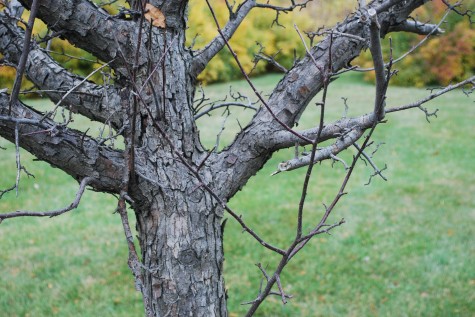 My skin surely reveals the amount of time I have spent outdoors; the trees are heir to all manner of insult from the environment that goes on non-stop. My corgi Milo has been trying to chase our resident squirrel up the trunk of my maple for three years now. His toenails have grooved the bark, but not damaged the tree. The variation in the appearance of tree bark makes it possible to identify trees by the bark alone; the diversity in plant forms is amazing. Old bark is beautiful in its texture and color. Rough, smooth, patchy, furrowed, scaly, exfoliating-we have so many words to describe the characteristics of bark.
My skin surely reveals the amount of time I have spent outdoors; the trees are heir to all manner of insult from the environment that goes on non-stop. My corgi Milo has been trying to chase our resident squirrel up the trunk of my maple for three years now. His toenails have grooved the bark, but not damaged the tree. The variation in the appearance of tree bark makes it possible to identify trees by the bark alone; the diversity in plant forms is amazing. Old bark is beautiful in its texture and color. Rough, smooth, patchy, furrowed, scaly, exfoliating-we have so many words to describe the characteristics of bark. The bark of a tree can be a host to all manner of mosses and lichens; some relationships are symbiotic. Other plants such as mistletoe, are parasites. Bark also protects a tree from sun scald, and frost cracks. In the summer, the horizontally held leaves of my maples protect its bark from sunburn. Lacking leaves, freezing and thawing in the winter can crack the part, and expose the inner living layers to pathogens. This big leaf linden conditions has many frost cracks which have just begun to heal.
The bark of a tree can be a host to all manner of mosses and lichens; some relationships are symbiotic. Other plants such as mistletoe, are parasites. Bark also protects a tree from sun scald, and frost cracks. In the summer, the horizontally held leaves of my maples protect its bark from sunburn. Lacking leaves, freezing and thawing in the winter can crack the part, and expose the inner living layers to pathogens. This big leaf linden conditions has many frost cracks which have just begun to heal.  This old crabapple reveals many scars-some from pruning, some from insects-some just a result of age. The appearance of the bark is an important element in the selection of trees for the landscape. In Michigan, bark is the prominent visual feature of a tree for the better part of six months. The climax beech maple forests in the upper peninsula of Michigan are breathtakingly beautiful-as are the old cedars, and birches. The trees are so old, large and tall, most of what you see is all that gorgeous bark.
This old crabapple reveals many scars-some from pruning, some from insects-some just a result of age. The appearance of the bark is an important element in the selection of trees for the landscape. In Michigan, bark is the prominent visual feature of a tree for the better part of six months. The climax beech maple forests in the upper peninsula of Michigan are breathtakingly beautiful-as are the old cedars, and birches. The trees are so old, large and tall, most of what you see is all that gorgeous bark. The Popples, also known as Aspens, have very beautiful smooth bark that has a decidedly greenish cast. Its sepia colored ridges and furrows are equally as attractive. The stands of poplar trees on the slopes in Aspen are my favorite part of that landscape. Bungeana pines, old Kousa dogwoods, and London Plane trees shed their old bark; this process known as exfoliation is incredibly beautiful.
The Popples, also known as Aspens, have very beautiful smooth bark that has a decidedly greenish cast. Its sepia colored ridges and furrows are equally as attractive. The stands of poplar trees on the slopes in Aspen are my favorite part of that landscape. Bungeana pines, old Kousa dogwoods, and London Plane trees shed their old bark; this process known as exfoliation is incredibly beautiful.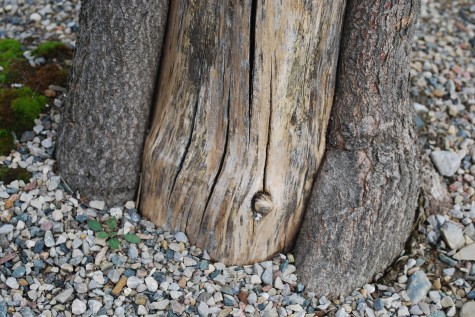 The bark of a tree will callus in response to a grave injury. This linden was struck hard by a careless driver; five years later it is still alive and thriving, though its woody interior is exposed on over one half of its trunk. The thickened bark is a healing response. Some bark grows thick enough such that it can be carefully harvested from a living tree use; this we call cork. The bark of the sequoia tree can grow as much as two feet thick-a proper scale for a tree of such great size.
The bark of a tree will callus in response to a grave injury. This linden was struck hard by a careless driver; five years later it is still alive and thriving, though its woody interior is exposed on over one half of its trunk. The thickened bark is a healing response. Some bark grows thick enough such that it can be carefully harvested from a living tree use; this we call cork. The bark of the sequoia tree can grow as much as two feet thick-a proper scale for a tree of such great size. 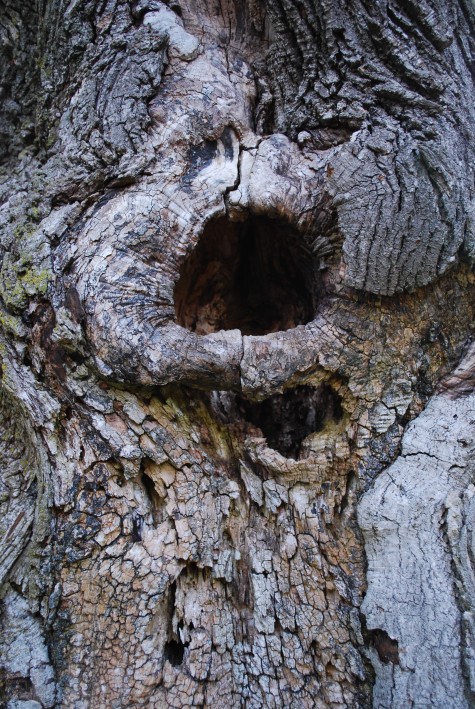 Though the bark protects the life of a tree, it does not protect forever. Like people, trees have a lifespan. This very old maple is in serious decline, partially from age. Trees with limited life spans may not be a good choice for a landscape you hope to have a long time.
Though the bark protects the life of a tree, it does not protect forever. Like people, trees have a lifespan. This very old maple is in serious decline, partially from age. Trees with limited life spans may not be a good choice for a landscape you hope to have a long time.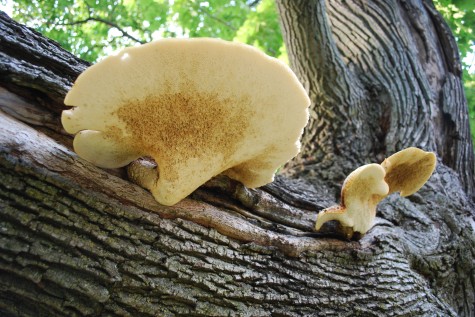
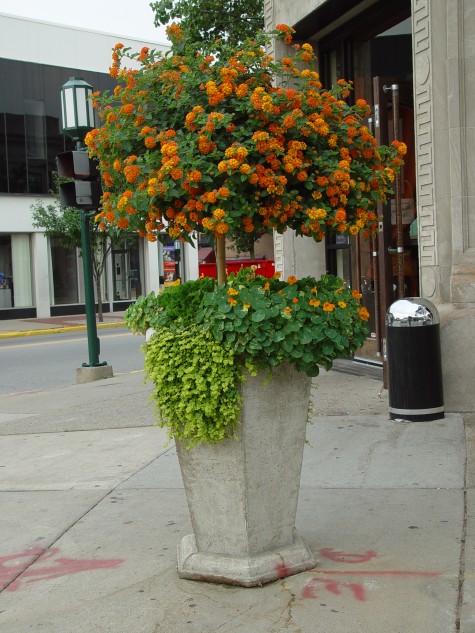 Topiary is the art of pruning, and training a plant to grow in whatever shape you might fancy. Plenty of plant species lend themselves to this kind of treatment. The above pictured lantana is seven years old. It began as a small plant, whose side branches were removed until the primary trunk was about four feet tall. A devoted grower then pinched back the main leader-the first step in the formation of the top. As I like slightly flattened spherical shapes in topiary, we keep the top pruned, and grow the side shoots wide. Lantana flowers profusely in hot weather, it makes a strikingly statuesque topiary plant. In the fall, I cut the head of the plant back by two-thirds,, strip all the remaining leaves off, and stash it in the greenhouse. I strip the leaves off, as lantana is a magnet for whitefly-and they multiply like lightening in a green house environment. What they require is plenty of trouble, but it is glorious in form and flower.
Topiary is the art of pruning, and training a plant to grow in whatever shape you might fancy. Plenty of plant species lend themselves to this kind of treatment. The above pictured lantana is seven years old. It began as a small plant, whose side branches were removed until the primary trunk was about four feet tall. A devoted grower then pinched back the main leader-the first step in the formation of the top. As I like slightly flattened spherical shapes in topiary, we keep the top pruned, and grow the side shoots wide. Lantana flowers profusely in hot weather, it makes a strikingly statuesque topiary plant. In the fall, I cut the head of the plant back by two-thirds,, strip all the remaining leaves off, and stash it in the greenhouse. I strip the leaves off, as lantana is a magnet for whitefly-and they multiply like lightening in a green house environment. What they require is plenty of trouble, but it is glorious in form and flower. 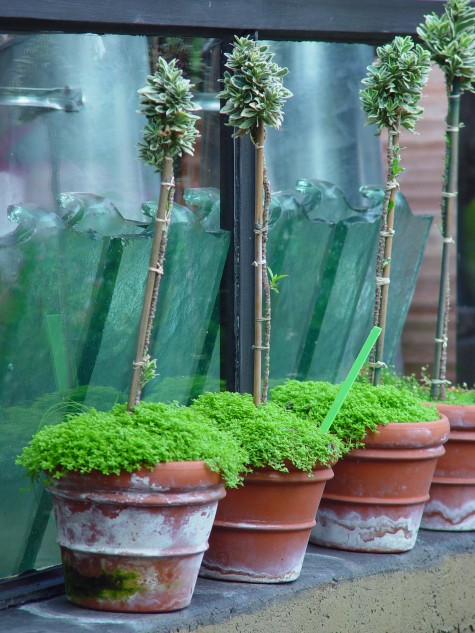 Well grown large topiary plants are expensive. It takes a lot of time to grow them on-sometimes years go by before a plant can be sold. This dwarf variegated euonymus with a batch of leaves atop a stem tells the story. In ten years, this plant will not be much taller-just much stockier, with a full head of leafy branches. As euonymus is a hardy shrub, they like to be wintered in a cool light place.
Well grown large topiary plants are expensive. It takes a lot of time to grow them on-sometimes years go by before a plant can be sold. This dwarf variegated euonymus with a batch of leaves atop a stem tells the story. In ten years, this plant will not be much taller-just much stockier, with a full head of leafy branches. As euonymus is a hardy shrub, they like to be wintered in a cool light place. 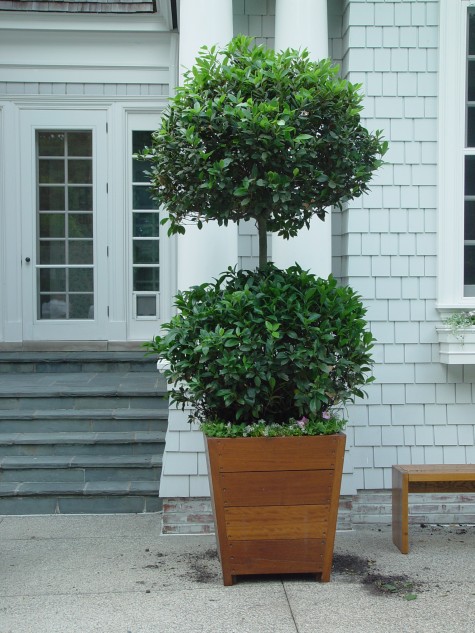 Bay Laurel is not hardy here, unfortunately-so a greenhouse is a necessity in the winter. This plant is 14 years old. This single ball topiary suckered at the base so persistently, I finally just let it grow. The formal shape is easy to keep up; you can see it needs a little haircut right now. There are many kinds of topiary shears available-I like short bladed snips, so I can cut branches without slicing into the leaves. Any leaf that is cut will show that telltale browing on that cut edge within days. �
Bay Laurel is not hardy here, unfortunately-so a greenhouse is a necessity in the winter. This plant is 14 years old. This single ball topiary suckered at the base so persistently, I finally just let it grow. The formal shape is easy to keep up; you can see it needs a little haircut right now. There are many kinds of topiary shears available-I like short bladed snips, so I can cut branches without slicing into the leaves. Any leaf that is cut will show that telltale browing on that cut edge within days. �
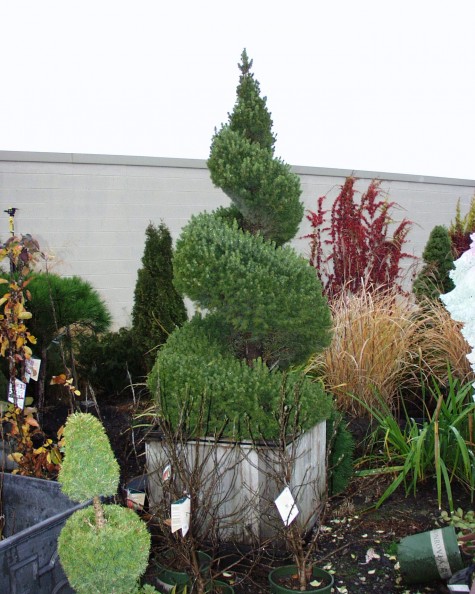

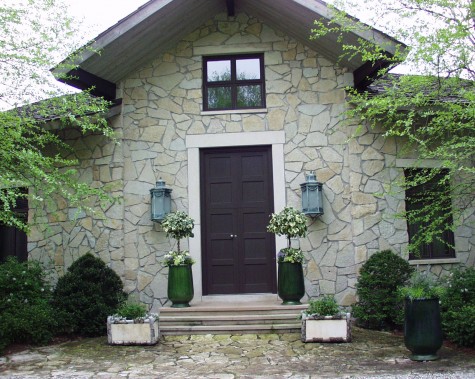 Ivy can be readily be trained over a wire form. This makes it an ideal subject for fast growing. The vines are tied to the form to provide completely coverage, and the vines are clipped as needed. Hedera algeriensis ” Gloire de Marengo”, or variegated Algerian ivy, has large glossy leaves, and a prominent white variegation; old topiaries grown from this plant are striking. A bonus-it is possible to winter ivy topiaries over in the house.
Ivy can be readily be trained over a wire form. This makes it an ideal subject for fast growing. The vines are tied to the form to provide completely coverage, and the vines are clipped as needed. Hedera algeriensis ” Gloire de Marengo”, or variegated Algerian ivy, has large glossy leaves, and a prominent white variegation; old topiaries grown from this plant are striking. A bonus-it is possible to winter ivy topiaries over in the house.  The coleus topiary I let go after two seasons-they seem to loose vigor. The minute you decide to grow a plant in any form which is not its natural form, there will be maintenance problems down the road. Plants tolerate being fooled with by people-they rarely love it. Plants that naturally lend themselves to this treatment are easier to look after.
The coleus topiary I let go after two seasons-they seem to loose vigor. The minute you decide to grow a plant in any form which is not its natural form, there will be maintenance problems down the road. Plants tolerate being fooled with by people-they rarely love it. Plants that naturally lend themselves to this treatment are easier to look after.